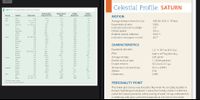Question

Transcribed Image Text:What is the angular diameter of Saturn (in degrees) as seen from the surface of Rhea? (Note: Necessary data can be found in this Celestial Profile
angular diameter (in arc seconds)
linear diameter
and in this table. Hint: Use the small-angle formula,
2.06 x 105
distance

Transcribed Image Text:1 of 1
Celestial Profile: SATURN
Table A-11 Principal Satellites of the Solar System
Distance from
Orbital Period
Orbital
Orbital
Primary
Satellite
Radius (km)
Primary (10' km)
days
Eccentkity
Inclination"
МOTION
Esrth
Moon
3614
272
OSS
Average distance from the Sun
Eccentricity of orbit
Inclination of orbit to ecliptic
Orbital period
Rotation period (sidereal)
14 X 12 x 10
9.58 AU (143 x 10° km)
Mars
Prebos
94
Lleimos
235
126
Aalh
0.056
lupelet
135 X 1x
lo
1820
422
177
2.5°
Europe
15NI
29.5 y
Grymede
3630
1001
Caleto
2M10
1884
10.57 h
11A
Satun
Janus
110 x 80 x 100
151.5
0.70
Inclination of equator to orbit
26,7°
196
185.5
15
Enceladus
250
2380
137
Tethys
530
2917
CHARACTERISTICS
Dure
550
377
24
Rhea
527
452
Equatorial diameter
1.21 X 10 km (9.45 De
5.68 X 1025 kg (95.2 Ma)
0.69 g/cm
1.1 Earth gravities
Tite
1222
Hyperion
203 X 110 X 1o
1454
2128
0.104
Mass
Lapetir
20
356
Phocte
106
12.900
0.163
190
Average density
Gravity at cloud tops
Escape velocity
Temperature at cloud tops
Uans
Mranda
235
1299
14
Ariel
1909
252
Umbrie
206.0
414
35.5 km/s (3.2 Va)
95 K (-290°F)
litenia
436
Oberon
790
5834
1346
Neptune
Proteus
206
1176
112
Trion
354 59
Albedo
0.34
Nereld
170
35580
20012
Pluto
Oblateness
0.098
Charon
25 x 18 X IN
487
24RS
or
Hycra
22 x 22 x 12
647
3820
*"F nay
PERSONALITY POINT
The Greek god Cronus was forced to flee when his son Zeus (Jupiter in
Roman mythology) tock power. Cronus fled to Italy, where the Romans
called him Saturn, protector of the sowing of seed. He was celebrated in
a weeklong wild party called the Saturnalia at the time of the winter
Expert Solution
This question has been solved!
Explore an expertly crafted, step-by-step solution for a thorough understanding of key concepts.
This is a popular solution
Trending nowThis is a popular solution!
Step by stepSolved in 3 steps

Knowledge Booster
Similar questions
- What is the orbital period of a scattered disk object with perihelion at 40 AU and aphelion at 100 AU? ( 2arrow_forwardThe planet Uranus was discovered in 1781, and Neptune, the next planet outward from the Sun, was discovered in 1846. Imagine you're an astronomer in 1846, and you start wondering if there's another planet out beyond Neptune. You decide to try and discover its existence using the same method that was used for Neptune. How will you do this? Group of answer choices You'll recruit a large number of astronomers to use their telescopes to carefully scan the sky in directions that are far from the ecliptic. The regions around the north and south celestial poles will probably be the best "hunting grounds" for the new planet. You'll examine Uranus and Neptune very carefully, on every clear night, for several years, to see if you can find any evidence that sunlight has been reflected off of the `new' planet, then off of Uranus or Neptune, before arriving on Earth. On rare occasions when Neptune passes in front of the Sun, as seen from Earth, you'll look carefully at the Sun (with a safe…arrow_forwardHow deep would be the eclipse caused by Jupiter transiting in front of the Solar disk, as observed from a distant star?arrow_forward
- Despite being composed primarily of gas, Jupiter and Saturn have large magnetic fields. This is primarily due to the presence of _________________ beneath its cloud tops.arrow_forwardThe asteroid Ceres has a mass of 9.39 x 1020 kg and an average radius of about 473 km (4.73 x 102 km). What is its escape velocity (in m/s)? 2GM (Hints: Use the formula for escape velocity, V. ; remember to convert units to m, kg, and s.) r m/s Could you jump off the asteroid? Yes Noarrow_forwardIf you were to record the spectrum of Saturn as well as the A ring, you would find light from one edge of the rings redshifted and light from the other edge blueshifted. If you observed a spectral line at a wavelength of 505 nm, what difference in wavelength (in nm) should you expect between the opposite edges of the rings? (Hints: The radius of the edge of the A ring is 136,500 km. Use the formula for orbital velocity,arrow_forward
- 1arrow_forwardWhat is the difference in orbital velocity between Saturn's two coorbital satellites if the semimajor axes of their orbits are 151,400 km and 151,500 km?arrow_forwardIf you were to record the spectrum of Saturn as well as the A ring, you would find light from one edge of the rings redshift and light from the other edge blueshift. If you observed a spectral line at a wavelength of 525 nm, what difference in wavelength (in nm) should you expect between the opposite edge of the rings? (Hint: The radius of the edge of the A ring is 136,500 km. Use the formula for orbital velocity and the formula for the Doppler shift.) _______ nmarrow_forward
- Uranus takes 84 Earth years to go around the Sun. How far away from the Sun is it, on average? Show your work. (a) 89.2 AU (b) 9.4 AU (c) 15.6 AU (d) 19.2 AUarrow_forwardWhat is the maximum angular diameter of the largest asteroid, Ceres, as seen from Earth?arrow_forward4 If a trillion (1012) asteroids, each 9 km in diameter, were assembled into one spherical body, how large (in km) would it be? (Note: The volume of a sphere km Compare that body's size to the size of Earth given in its celestial profile. d %3D dEarth Need Help? Read Itarrow_forward
arrow_back_ios
arrow_forward_ios